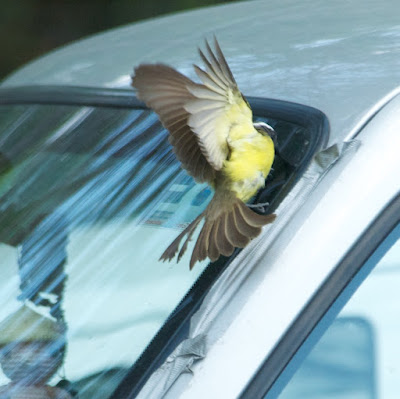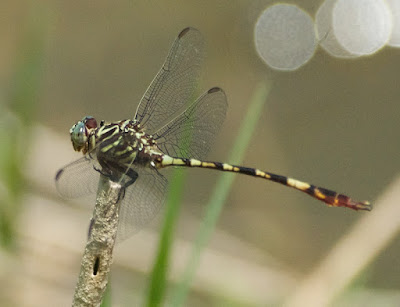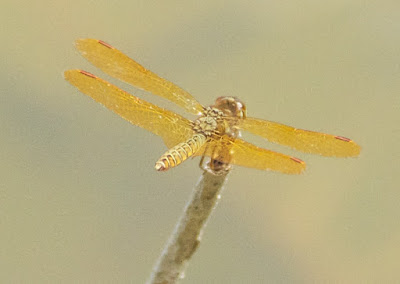As I have said before, Social Flycatchers are not particularly social, and this one was downright aggressive.
Tropical America is full of tyrant flycatchers that look, more or less, like Social Flycatchers but differ in details of size, plumage and bill shape. This is the commonest (and most northerly) of them, the Great Kiskadee (Pitangus sulphuratus). 'Kiskadee' imitates the bird's ringing call (in French-speaking countries it is called 'Qu'est qu'il dit' for the same reason).
Just off the parking lot I found a young Lineated Woodpecker (Dryocopus lineatus), a tropical relative of the Pileated Woodpecker (D. pileatus) of North America. It seemed to have been not long out of the nest. Perhaps the stub it was sitting on was the best tree itself, but the vegetation around it was too thick to be worth checking (aside from disturbing the bird, the last time I had thrashed around in grassy vegetation in Mexico I had gotten a load of chigger bites for my pains).
In a corner of the lot I found a short trail that allowed me to get off-road for a few metres. On it I came across a Mexican Bluewing (Myscelia ethusa), a nymphalid butterfly that occasionally shows up in extreme south Texas burn otherwise ranges south to Colombia. It is one of a large group of mostly tropical American butterflies, the Biblidinae, many of whose adults fly to the ground to puddle or to feed on rotting fruit.
To my delight, the trail led me to a small, reed-lined pond that swarmed with dragonflies. I had only a few minutes before I had to join the others, but that was enough for me to get more or less respectable photographs of five different species. Together they formed a little community that seemed strikingly equivalent to dragonfly communities I have watched in Sarawak. Of course it would take more than a few minutes' observation to prove this notion, but the parallels were interesting.
To start with, I found a large, banded gomphid dragonfly that reminded me of the Ictinogomphus dragonflies of Asia. In this case, though, it was a male Broad-striped Forceptail (Aphylla angustifolia), so named because of the impressive sexual appendages, or cerci, at the tip of his abdomen. Forceptails as a group are purely American, and this species ranges from the Gulf Coast south to Guatemala.
The Mexican Scarlet-tail (Planiplax sanguiniventris), a handsome red-and-blue dragonfly, recalls some of the Orthetrum dragonflies of the Old World. It ranges from the Gulf Coast of Mexico (and, rarely, southern Texas) to Nicaragua. The other four species in the genus are South American, though one of them reaches Panama.
Perithemis mooma is one of the amberwings. These are smallish dragonflies, perhaps equivalent to some of the smaller Asian species. The tiniest Sarawak dragonfly, Nannophya pygmaea, is considerably smaller than this, but its female shares with amberwings a close resemblance to a wasp or biting fly. Are either, or both, mimics? P. mooma, if I have the species right here, does not reach north of Mexico (though it ranges southward into South America) and so does not seem to have a common English name.
The Roseate Skimmer (Orthemis ferruginea) is another Orthetrum lookalike (and probably closer to Orthetrum than is Planiplax, above), though I do not know of any Orthetrums that are as pink as this. It ranges from the southern United States to Brazil.
The Spot-tailed Dasher (Micrathyria aequalis) reminds me of the Asian (and Australian) Diplacodes. It belongs to a large genus of tropical American dragonflies; this one also reaches Florida and southern Texas.
The only damselfly I saw on the pond was a Mexican Wedgetail (Acanthagrion quadratum), a member of a species common in Middle America but barely crossing the US border into extreme southern Texas. Fortunately it is easy to identify (which is more than can be said for many blue-and-black dragonflies in North America): the long, slender, mostly back abdomen and the large, clearly separated occipital spots on the back if its head are distinctive field marks.
I was surprised and delighted with the little pond and its dragonflies, and would have liked to have spent a good deal longer there. However, we had a long way to go back to Veracruz City (and besides, Eileen and Davin couldn't find anything worth buying at the souvenir stalls). Our brief trip to Mexico was near its end, and I will finish with only a couple of quick photos from our drive home: a distant group of Least Grebes (Tachybaptus dominicus)...
...and basking Morelet's crocodiles (Crocodylus moreletii) in a crocodile farm. I was told that the chief reason that the Mexican government decided to hold the CITES Animals Committee meeting (my reason for being there) in Veracruz was to show off its croc farming programme. Morelet's leathers are supposedly (according to those who care about such things) superior to those of the American Crocodile (C. acutus). I will leave it up to my readers to draw any moral they may care to from this final photograph.
To start with, I found a large, banded gomphid dragonfly that reminded me of the Ictinogomphus dragonflies of Asia. In this case, though, it was a male Broad-striped Forceptail (Aphylla angustifolia), so named because of the impressive sexual appendages, or cerci, at the tip of his abdomen. Forceptails as a group are purely American, and this species ranges from the Gulf Coast south to Guatemala.
The Mexican Scarlet-tail (Planiplax sanguiniventris), a handsome red-and-blue dragonfly, recalls some of the Orthetrum dragonflies of the Old World. It ranges from the Gulf Coast of Mexico (and, rarely, southern Texas) to Nicaragua. The other four species in the genus are South American, though one of them reaches Panama.
Perithemis mooma is one of the amberwings. These are smallish dragonflies, perhaps equivalent to some of the smaller Asian species. The tiniest Sarawak dragonfly, Nannophya pygmaea, is considerably smaller than this, but its female shares with amberwings a close resemblance to a wasp or biting fly. Are either, or both, mimics? P. mooma, if I have the species right here, does not reach north of Mexico (though it ranges southward into South America) and so does not seem to have a common English name.
The Roseate Skimmer (Orthemis ferruginea) is another Orthetrum lookalike (and probably closer to Orthetrum than is Planiplax, above), though I do not know of any Orthetrums that are as pink as this. It ranges from the southern United States to Brazil.
The Spot-tailed Dasher (Micrathyria aequalis) reminds me of the Asian (and Australian) Diplacodes. It belongs to a large genus of tropical American dragonflies; this one also reaches Florida and southern Texas.
The only damselfly I saw on the pond was a Mexican Wedgetail (Acanthagrion quadratum), a member of a species common in Middle America but barely crossing the US border into extreme southern Texas. Fortunately it is easy to identify (which is more than can be said for many blue-and-black dragonflies in North America): the long, slender, mostly back abdomen and the large, clearly separated occipital spots on the back if its head are distinctive field marks.
I was surprised and delighted with the little pond and its dragonflies, and would have liked to have spent a good deal longer there. However, we had a long way to go back to Veracruz City (and besides, Eileen and Davin couldn't find anything worth buying at the souvenir stalls). Our brief trip to Mexico was near its end, and I will finish with only a couple of quick photos from our drive home: a distant group of Least Grebes (Tachybaptus dominicus)...
...and basking Morelet's crocodiles (Crocodylus moreletii) in a crocodile farm. I was told that the chief reason that the Mexican government decided to hold the CITES Animals Committee meeting (my reason for being there) in Veracruz was to show off its croc farming programme. Morelet's leathers are supposedly (according to those who care about such things) superior to those of the American Crocodile (C. acutus). I will leave it up to my readers to draw any moral they may care to from this final photograph.





























No comments:
Post a Comment